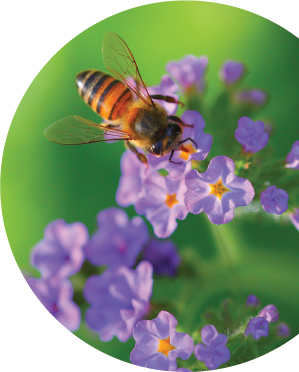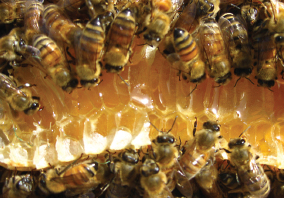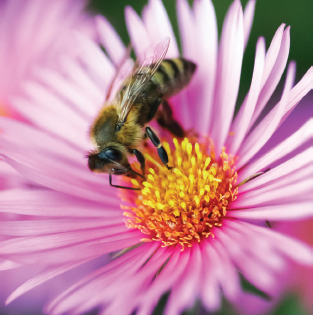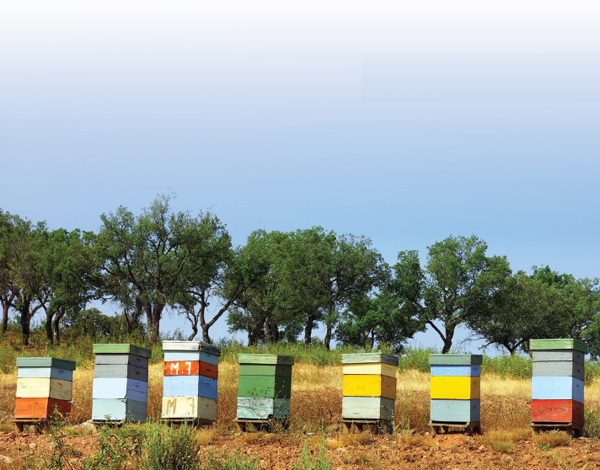![]() s emphasized throughout this book, bees collectively possess the largest body of knowledge of flowering plants in existence. Their expertise in botany, phytochemicals, and medicinal plants is profound, and it’s abundantly reflected in the remarkable healing properties of all the beehive products. Their amassed wisdom is as valuable to us as it is to them, and it can play a crucial role in protecting both human and bee societies.
s emphasized throughout this book, bees collectively possess the largest body of knowledge of flowering plants in existence. Their expertise in botany, phytochemicals, and medicinal plants is profound, and it’s abundantly reflected in the remarkable healing properties of all the beehive products. Their amassed wisdom is as valuable to us as it is to them, and it can play a crucial role in protecting both human and bee societies.

The preceding chapters offered a great deal of information about the four medicinal beehive products and what bees have to teach us. In this chapter, I’ll share some information on using these products—pollen, propolis, royal jelly, and honey— medicinally. I’ll begin with some general guidelines and conclude with recipes for remedies that I’ve developed over the years. This chapter will help you take a hands-on approach to health and healing. As you learn to use bee products medicinally and to make your own home remedies with beehive products, the results will speak for themselves. Indeed, you’ll set such a compelling example that others will follow.
Children usually don’t like to eat bee pollen by the spoonful, and the same is true of some adults. You can purchase chewable pollen wafers, but they are expensive, and picky eaters will still reject them. Unfortunately, these are exactly the people who tend to eat insufficient amounts of produce and therefore can benefit most from supplemental bee pollen.
As mentioned in the chapter on bee pollen, don’t make the mistake of trying to sneak a bit of bee pollen in a large amount of food. Its distinctive flavor will be noticeable, and your cover will be blown. Instead, make up small, bite-sized morsels, as these will be far more tolerable. For children, make consumption mandatory, just like a chewable vitamin. If you opt to experiment and create your own pollen treats, just remember that pollen’s nutrients are fragile. Never put pollen directly into hot foods or bake with it. As people’s palates grow accustomed to the pollen, you can gradually increase the amount.
Here are a few recipe suggestions:
• Dip a small piece of dark chocolate in honey, then roll it in bee pollen. You can mix the bee pollen with chopped nuts or cookie crumbs. The entire morsel should be eaten at once, without licking off the coating.
• Make crispy rice cereal treats. If those eating the treats can tolerate chocolate and peanut butter, use cocoa-flavored crispy rice cereal and substitute warm peanut butter for the margarine. After spreading the mixture in a pan and allowing it to cool completely, cut it into small squares. To assemble each morsel, put some bee pollen on top, about 1/2 teaspoon, and roll into a bite-sized ball.
• Mix about 1/2 cup of peanut or almond butter with 1 cup of crispy rice cereal and 1 scant tablespoon of bee pollen. Form the mixture into bite-sized balls. If they’re sticky, roll them in a bit of additional cereal. The cereal must be sweet, so you may want to use a flavored variety.
It’s important to realize that you don’t usually “catch” a cold or upper respiratory infection. The viruses and bacteria that cause these are already present in your body and the surrounding environment, and your immune system usually keeps them in check. However, if you’ve been stressed, unhappy, sleeping or eating poorly, or otherwise neglecting your health, the microbes can proliferate to a level where they cause symptoms. Fortunately, taking propolis can often help prevent illness, or if you do get sick, it can reduce the severity or duration of symptoms.
During cold and flu season, I recommend taking 500 milligrams of propolis daily as a preventive measure. When taking airline flights or tending people who are sick, increase the amount to 1,000 milligrams daily.
As soon as you feel a sore throat or sinus congestion coming on, coat your throat with propolis spray four or five times a day. Alternatively, or in addition to the propolis spray, you can take 3 capsules (a total of 1.5 grams or 1,500 milligrams) of propolis per day or 1 dropper of propolis extract four or five times a day. Also take 1,000 to 2,000 milligrams of vitamin C each time and get in bed as soon a possible. Getting twelve hours of sleep and taking these supplements will probably prevent you from developing a full-blown cold or sinus infection. If you don’t feel you have the time to rest, keep this in mind: one day of resting and taking care of your health may well prevent seven days of misery and poor work performance.
You can enhance the success of this approach by adding other powerful botanical products that interfere with the growth of common respiratory pathogens and help flush them out of the body. A good combination is propolis, Japanese honeysuckle bud (Lonicera japonica), and forsythia berry (Forsythia suspensa). You can use either capsules or extracts. If using capsules, take 3 capsules of each four or five times daily with plenty of water. If using extracts, mix them together and take them all at once to minimize tasting them.
Honey can also be helpful. Two to four times a day, drink a cup of hot tea (preferably decaffeinated, so you can sleep) with 1 to 2 tablespoons of honey mixed in and one slice each of orange and lemon (with the peel) added. Sip gently to coat your throat.
If you have an existing respiratory infection, follow this protocol in conjunction with taking antibiotic drugs, not in place of them. I recommend taking 4 to 8 grams of propolis per day to help clear upper respiratory infections.
Propolis doses of 3 to 5 grams, or 3 to 5 droppers of liquid extract, per day are required to reduce pain associated with chronic inflammation. (As with all bee products, if you are allergic to bee stings, be especially cautious about using propolis.) After four to six weeks, you can reduce this dose by half if you are experiencing good results.
For treating acute inflammation (such as hay fever, insect stings, sinusitis, sports injuries, or sprains), use 4 to 7 grams or droppers per day for three to six days. Please consult a health care professional if acute inflammation continues unabated for ten days or longer.
To treat allergies with bee pollen, select a pollen that’s pleasing to your palate, because you’ll be using a lot of it. During hay fever season or whenever you’re exposed to allergens, double, triple, or quadruple your daily bee pollen intake, up to 8 teaspoons maximum per day. Divide your intake and ingest it three to five times per day, each time including 1,000 milligrams of vitamin C (the best and safest natural antihistamine) and a propolis supplement. The idea is to get enough antihistamine and antiallergenic phytochemicals into your body to make a real improvement in acute symptoms.

Some manufacturers sell special bee pollen allergy preparations designed to help acute symptoms. However, they won’t help you if you take only one or two capsules per day, because this won’t deliver enough of the active phytochemicals and vitamins.
Plantar warts are stubborn infections from a papillomavirus that occurs on the base of the foot. When you get one, use the following treatment right away because they can spread. For this remedy you’ll need concentrated acetic acid, which is used as an organic weed killer. You can purchase it at home and garden shops and possibly at large natural food stores. You’ll only need a little bit of the bottle for the treatment, but the remainder is great to use in the garden because it doesn’t harm bees! Alternatively, you can use raw apple cider vinegar or commercial salicylic acid treatment pads, but it may take longer to achieve results. You’ll also need propolis capsules, rubbing alcohol, and essential oil of oregano, tea tree, manuka, or cinnamon leaf.
1. After washing your feet with soap (which should be done daily), cut away or file off the top of the wart. Soak a small piece of cotton or gauze in acetic acid and cover the wart. Be forewarned that it will sting! Bandage the area tightly. Repeat this step for 3 days, checking for and cutting off dead tissue each day. Sterilize your cutting tools after each use.
2. On the fourth day, combine the contents of 1 propolis capsule (500 milligrams) with 5 drops of alcohol (either rubbing alcohol or distilled spirits) and 5 drops of oregano oil. (You can substitute tea tree, manuka, or cinnamon leaf oil for the oregano oil.) Mix the ingredients together to make a paste. Apply the paste to the wart and bandage tightly. Repeat for 3 days.
3. Return to step 1 for another 3-day cycle, applying the acetic acid and continuing to cut off dead tissue. Repeat these cycles until the wart no longer has a “cauliflower” appearance and no black spots or roots are visible.
4. If at any point the treated skin becomes very irritated or bleeds a lot, take 3 days off and instead dress the area with raw honey or honey mixed with royal jelly and cover it with a bandage.
TIP: This treatment works for warts on the hands and body, but go very lightly with the acetic acid. These areas are more sensitive than the soles of the feet, where the skin is much thicker and there are fewer nerves close to the surface. It may be advisable to do each step for only 2 days, rather than 3.
I often use a combination of raw high desert honey and propolis for wound treatment because it promotes rapid healing and isn’t too runny under the bandage. Use a ratio of 1:2 capsules (total about 1 gram) of propolis powder to 1 to 2 tablespoons of raw dark honey.
Raw comb honey with wax and propolis is also an excellent choice because it’s thick and tends to stay in place on the wound. Plus, the wax and propolis work with the honey to form a protective antimicrobial seal on the wound.
Simply dip a clean tongue depressor stick or similar applicator or a small utensil into the honey-propolis mixture and spread it over the wound in an even layer. Dress the wound with a large enough bandage that the honey mixture won’t squeeze out. Change the bandage twice per day for fresh minor wounds and three times per day for wounds that are large, have become infected, or aren’t healing well.
For infected wounds, it’s best to soak them in hot salt water for 5 to 10 minutes when you change the dressing; the water should be hot enough that you have to ease into it. You’ll be surprised how this helps promote healing. The combination of consistent soaking and dressing the wound with raw honey and propolis will reliably cure infections caused by antibiotic-resistant bacteria.
Another option is to use a propolis salve, which you can purchase at natural food stores, create by mixing propolis into any ointment, or make at home using the formulas on pages 58 and 59. Propolis salves are safe for children and pets. In fact, as pet treatments they have a distinct advantage over ointments based on petroleum jelly: dogs and cats won’t enjoy licking a salve with propolis and manuka oil, for example, like they enjoy petroleum jelly.

This salve is excellent for treating dermatitis, cracked hands, and diaper rash. It incorporates beeswax, which has a long history of use in wound salves, thanks to its healing and anti-inflammatory properties. When melting the beeswax, a candy or meat thermometer can be useful for checking the temperature of the mixture. If using the salve on an infant, don’t add tea tree or manuka oil unless you’re certain the child isn’t allergic to the essential oil.
Open the propolis capsules into a small dish. Open the capsules of vitamins A, D, and E and evening primrose oil by carefully cutting a slit in each with the tip of a sharp knife. Squeeze the contents into the dish. Add the vitamin C and borax and stir until just combined.
Put the beeswax and almond oil in a small, heavy stainless steel or ceramic saucepan over low heat. Heat, swirling the pan often, until the mixture reaches 175 degrees F (80 degrees C), at which point the melted beeswax will become transparent. Don’t let the mixture boil. Remove from the heat and let cool briefly, just until a faint haze of opaque wax forms. Whisk with a small stainless steel whisk until the mixture is fully opaque and has the consistency of very soft butter (100 to 120 degrees F, or 40 to 50 degrees C).
Add the propolis mixture and whisk vigorously and continuously. The mixture will initially soften but then stiffen; when it’s still a little soft and warm, but not hot, stir in the herbal extract and optional essential oil. Continue whisking until the mixture is cool. Transfer to small, sterilized containers and seal tightly. Store one container at room temperature, away from heat and light, for immediate use, and refrigerate the others. To use, clean the wound well and dry it thoroughly. Apply a thin layer of the salve, then bandage.
Heaping 1/2 teaspoon propolis powder from capsules
6 to 8 (10,000 to 25,000 IU) soft-gel capsules vitamin A
6 to 8 (400 to 1,000 IU) soft-gel capsules vitamin D
4 to 6 (400 IU) soft-gel capsules vitamin E
6 (1,000 to 1,300 mg) soft-gel capsules evening primrose or borage oil
1/2 teaspoon ascorbic acid (vitamin C) powder
1/8 teaspoon borax powder
2 teaspoons shaved beeswax
1/4 cup cold-pressed almond, sesame, hazelnut, or olive oil
2 to 3 teaspoons glycerin- or ethanol-based liquid herbal extract, such as comfrey, chamomile, yarrow, calendula, or mixed herbs (optional)
1/2 teaspoon tea tree or manuka essential oil (optional)
When treating wounds, you can simply apply honey first and then sprinkle the propolis from a capsule on top. Alternatively, you can combine these ingredients in a paste for quick application, as in this recipe. This paste is especially effective for burns, abrasions, blisters that have popped, skin ulcers, or inflamed wounds that are healing slowly. Manuka or eucalyptus honey would be especially effective in this recipe, but any dark honey will do. If using this formula to treat burns, including the optional lavender oil will make the paste especially soothing.
Open the propolis capsule into a small dish. Add the honey, colostrum, and optional essential oil and mix to form a smooth but stiff paste. Transfer to a small, sterilized container and seal tightly. Store in a cool, dark place, and avoid getting moisture in the container.
To use the paste, wash the affected area gently and blot dry. Cover with a thin layer of the paste, then wrap with gauze and use first aid tape to hold the dressing in place. Change the dressing twice daily or, if infected, three times daily. At a minimum, clean the wound and apply a fresh dressing each night before you go to bed and let the miracle of propolis and honey work while you sleep!

1 capsule (1 gram) propolis powder
2 tablespoons raw dark honey
2 rounded teaspoons colostrum powder, or 1 teaspoon each colostrum powder and freeze-dried royal jelly
6 drops manuka, tea tree, eucalyptus, or lavender essential oil (optional)
This gel is excellent both for scar treatment and for overall skin protection. When I was pregnant, I used it to prevent stretch marks. It’s also great for helping prevent scarring from large wounds or surgery. The recipe calls for sea buckthorn oil, which is red and can stain, so be cautious about getting it or the gel on clothing or other fabrics.
Squeeze or pour the aloe gel into a bottle that holds at least 3/4 cup and has a tight-fitting lid. (You need to be able to shake the bottle vigorously.) Open the capsules of vitamins A, D, and E and evening primrose oil by carefully cutting a slit in each with the tip of a sharp knife. Squeeze the contents into the bottle. Add the royal jelly, sea buckthorn oil, and calendula extract and shake thoroughly. If the mixture is too thick to mix effectively, add a few drops of rubbing alcohol or more sea buckthorn oil or calendula extract. Because royal jelly is highly perishable, store the gel in the refrigerator. For short-term use, you can store a small amount in a sterilized jar in a cool, dark place.
To use the gel, first wash the area to be treated. Shake the bottle vigorously, then apply the gel to the area, rubbing it in thoroughly. If using the gel to prevent stretch marks during pregnancy, begin using it at month five. Apply it twice per day, at least once after bathing.
1/2 cup 100% aloe vera gel
8 soft-gel (10,000 to 25,000 IU) capsules vitamin A
8 soft-gel (400 to 1,000 IU) capsules vitamin D
6 (400 IU) soft-gel capsules vitamin E
10 (1,000 to 1,300 mg) soft-gel capsules evening primrose or borage oil
2 to 3 tablespoons fresh royal jelly
2 to 3 teaspoons sea buckthorn oil
3 droppers (2 to 3 teaspoons) calendula extract
TIPS
• The formula calls for fresh royal jelly. If you only have freeze-dried royal jelly on hand, mix it with a few drops of water and a few drops of rubbing alcohol. Stir well. The royal jelly is rehydrated when it has the consistency of heavy cream. The amount of water and rubbing alcohol needed will depend on the product used and the ambient humidity.
• For an effective sunburn or under-eye treatment (remove contcts before applying), use just the aloe vera gel and royal jelly. Mix well. For drier skin, add the contents of 2 to 4 capsules of evening primrose or borage oil.
• Feel free to experiment with this recipe to create your own personalized skin care treatments.
Alcohol-based sprays are the best choice for sore throats and preventing respiratory infections, and mouth rinses are the best choice for dental and oral issues. If my throat is scratchy, I like to back up the spray with a few propolis capsules, which contain components that don’t dissolve in an extract, no matter what type of solvent is utilized.
Combine the water and propolis extract. Transfer to a glass bottle or spray bottle, and store at room temperature. Use as needed. Increase the ratio of extract to water when a stronger preparation is necessary.
20 parts water
1 part ethanol-based propolis extract

If you suffer from an ulcer, gastritis, or acid reflux, you’ve probably already learned not to go to bed on a full stomach and to avoid alcohol and carbonated beverages late in the evening—or altogether. Taking the following formula at bedtime can also help prevent symptoms and promote healing. If you can find Brazilian green propolis, it will be especially effective in this formula. Alternatively, you can omit the propolis.
Open the propolis capsules into a small dish. Add the honey and royal jelly and mix well. Take the formula on an empty stomach about 20 minutes before retiring, following it with water if you wish. Don’t drink anything other than water after taking the formula.
2 capsules (1 gram) propolis powder, or 1/2 dropper propolis extract (optional)
1 to 2 tablespoons manuka or buckwheat honey, preferably raw
2 teaspoons fresh royal jelly
